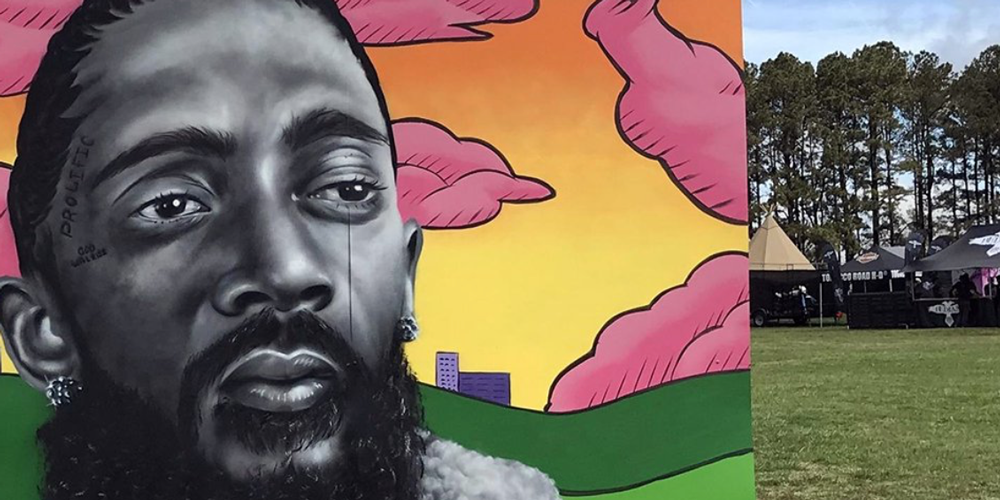
Hip-hop’s mourning for Nipsey Hussle shows beauty can be found in brokenness
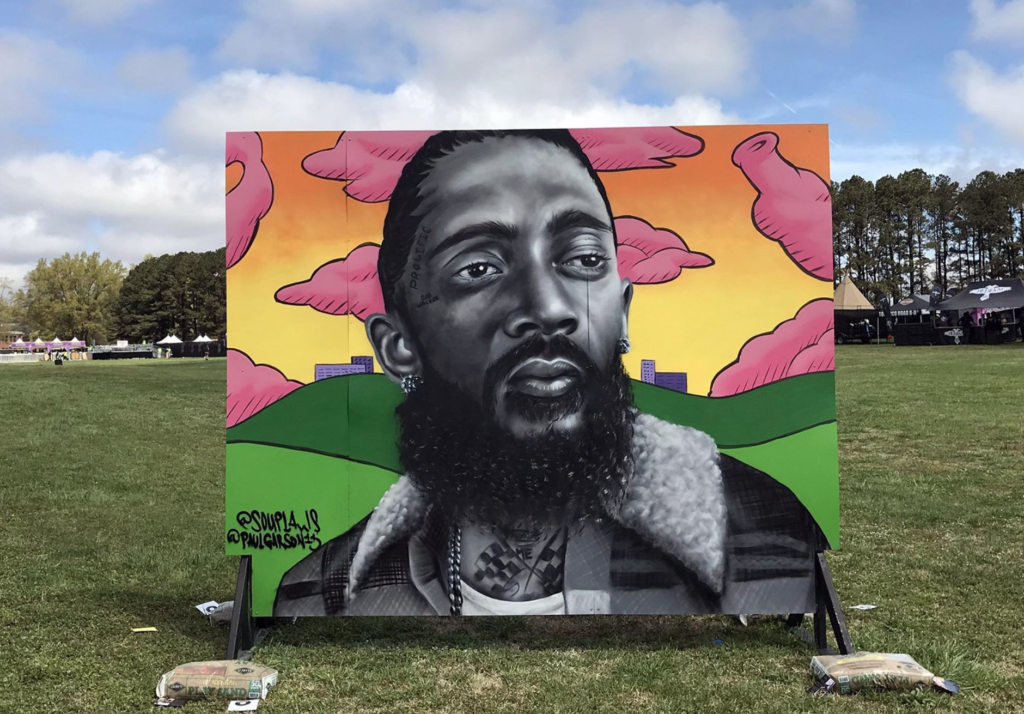
A mural of Nipsey Hussle at the Dreamville Festival on April 6, 2019, in Raleigh, N.C. Photo courtesy of Dreamville Festival
(RNS) — When hip-hop writer Yoh Phillips arrived at Dreamville Festival on April 6, 2019, he found a 10-foot mural of the late rapper Nipsey Hussle planted in the middle of Dorothea Dix Park.
Then he noticed Nipsey Hussle seemed to be everywhere.
He saw sweaters from the artist’s “Crenshaw” project and heard performer after performer mention the impact and legacy of Nipsey during the daylong festival. J. Cole, who is the founder of Dreamville Records and the mastermind behind the festival, performed a tribute with a montage from Nipsey’s life in the background.
But the mural painted by Paul Garson and Nik Soupé — and the timeline of its creation — stuck with Phillips.
“They had one week to paint that,” he said.
When artist Nipsey Hussle was shot at his clothing store in L.A. at the end of March, the shocked hip-hop community stopped and mourned. Musicians offered tributes on social media as his Grammy-nominated album “Victory Lap” rose back to number two on the Billboard 200 chart.
Whenever the hip-hop community loses an artist, it loses a member of the family.
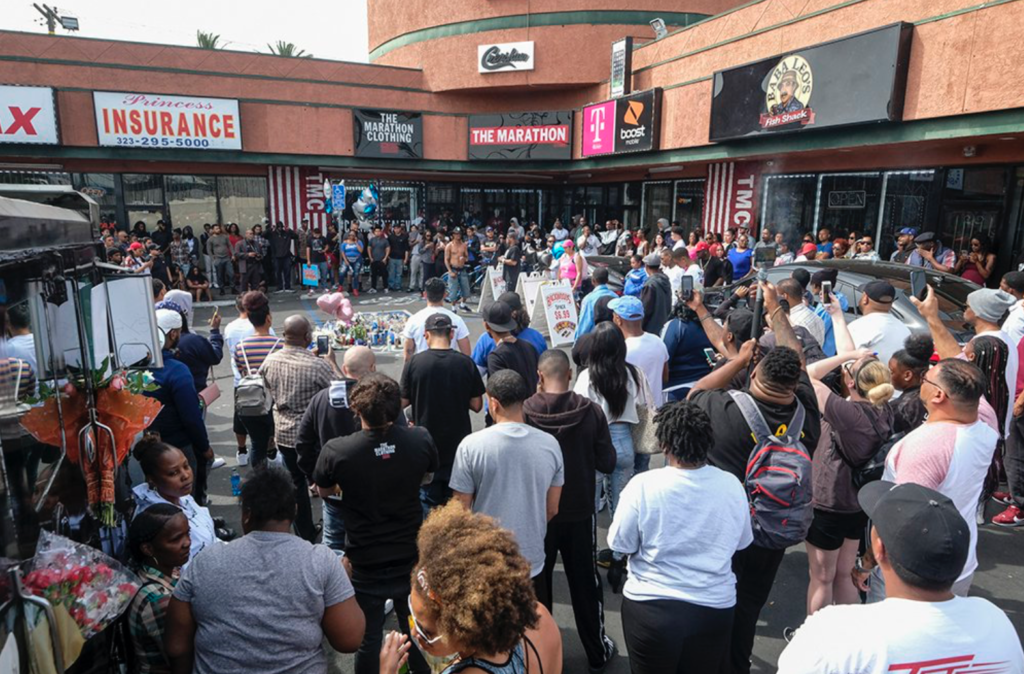
Fans of rapper Nipsey Hussle gather at a makeshift memorial in the parking lot of The Marathon Clothing store in Los Angeles, Monday, April 1, 2019. Hussle was killed in a shooting outside his clothing store on Sunday. (AP Photo/Ringo H.W. Chiu)
The mourning binds people together as they reflect on the life and legacy of an artist taken too soon and reveals the foundation of hip-hop culture: beauty from brokenness.
That’s what Dreamville Festival and the last-minute mural were for Phillips and many others: a space to mourn, remember Nipsey Hussle and return to what the hip-hop community is all about.
“Usually festivals feel like everyone’s there for something different, but Dreamville was a place for everyone to remember, to reminisce, to acknowledge all that Nipsey meant,” said Phillips. “There was something very church-like about it.”
The hip-hop community is no stranger to loss.
Some of the most public deaths in music have been hip-hop legends, from Tupac and Biggie in the ’90s to Mac Miller and Nipsey Hussle most recently.
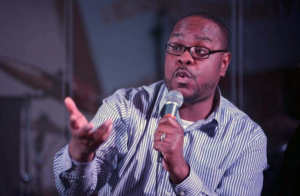
Jonathan Brooks, pastor of Canaan Community Church in Chicago and author of “Church Forsaken,” still mourns the death of Phife Dawg of A Tribe Called Quest.
Phife died at the age of 45 in March 2016 from complications related to diabetes. Brooks said the artist’s death was like losing a friend.
“So many members of my family and my church have diabetes, so that made the loss even more personal,” Brooks said.
Nipsey’s death because of gun violence and gang activity is sadly also a common theme in hip-hop.
“The lifestyle that Nipsey lived related to his demise,” Brooks said of Nipsey’s known gang affiliation. “But it’s also the lifestyle that he was trying to eradicate.”
Nipsey tried to defuse gang violence in his community.
He invested in Vector 90, a co-working space that teaches science, technology and math to kids from the inner city, and he founded The Marathon Clothing, a creative space for music merchandise and community.
It was outside The Marathon Clothing that Nipsey was shot.
Central to hip-hop culture and community is the violent context and the resilient life that survives within it. The pairing of difficulty and survival is the history of hip-hop, Brooks said.
“In the ’70s, people said that the Bronx was burning and that there was nothing beautiful there. From those ashes, hip-hop rises,” he said. “It’s the epitome of beauty in brokenness.”
That type of beauty in brokenness is also what draws writer Donna-Claire Chesman to hip-hop culture.
Donna-Claire Chesman. Courtesy photo
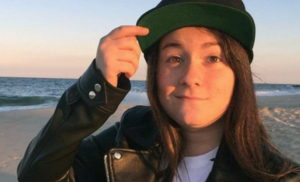
Donna-Claire Chesman. Courtesy photo
She said that hip-hop has a spirituality to it.
“A lot of the reasons that people turn to religion is the reason that I turn to music,” she said. “There’s so much solace to be found in hip-hop.”
Right after news of Mac Miller’s death on September 7, 2018, she tweeted in disbelief: “This is the man that got me through my brain surgery.”
Mac’s music was there for her through the ups and downs of her life, and losing him was crushing.
That day, she wrote her piece, “Thank you, Mac Miller,” before promptly returning to the floor to cry.
Since then, Chesman has been writing a yearlong weekly reflection called “The Year of Mac” about the scope and impact of Mac’s music.
She talks about the impact that the death has on the hip-hop community.
“When tragedy happens, the community gets stronger and the community expands,” she said.
She doesn’t agree with those who judge others who only started listening to an artist after their death.
“It doesn’t matter when they tuned in, it just matters that they did,” she said.
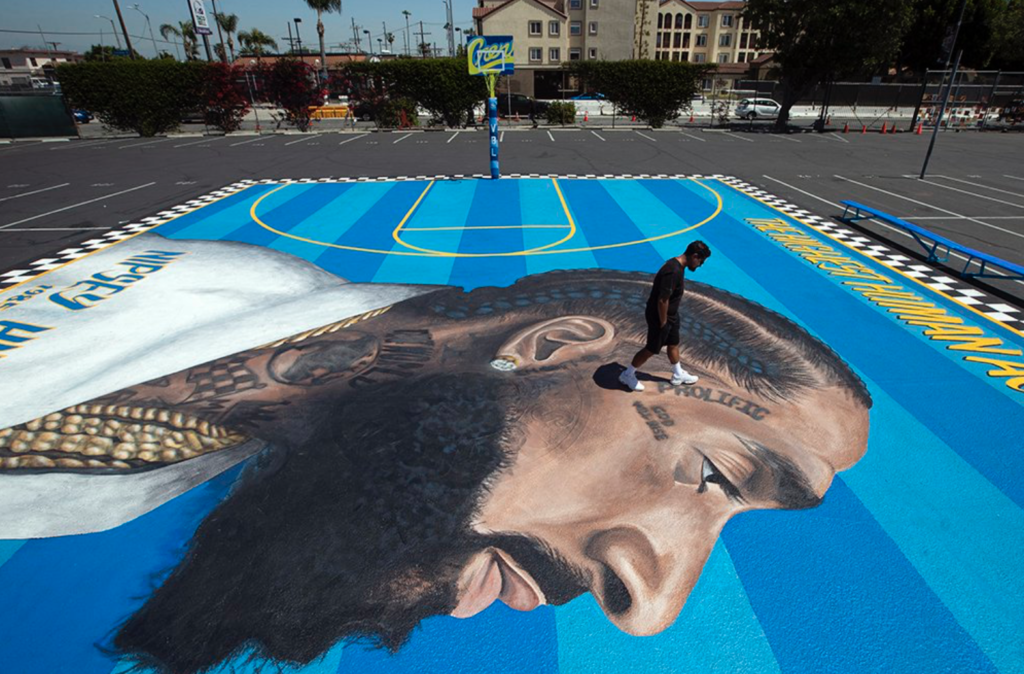
Mural artist Gustavo Zermeno Jr. walks on a basketball court mural he dedicated to slain rapper Nipsey Hussle in Los Angeles on April 17, 2019. More than 50 colorful murals of Hussle have popped up in Los Angeles since the beloved rapper and community activist was gunned down outside his clothing store. (AP Photo/Jae C. Hong)
Brooks agreed.
He said Nipsey Hussle reaches a larger audience now than when he was alive. His final music video, a collaboration with DJ Khaled and John Legend, was released on Thursday (May 16).
And his legacy lives on.
“This is why hip-hop is different than other cultures,” Brooks said. “We try to embody the spirit of an artist in the way that we live.”
This message also impacts his ministry as a pastor.
“When I preach at funerals, I say that the best tribute you can give to this person is how you live moving forward. That’s a very hip-hop way of thinking.”
(Chris Karnadi is an assistant editor at Duke Divinity’s Faith & Leadership and a columnist at Sojourners. Follow him on Twitter @chriskarnadi. The views expressed in this commentary do not necessarily reflect those of Religion News Service.)
